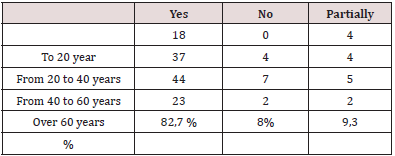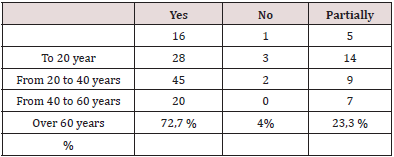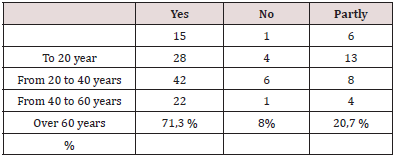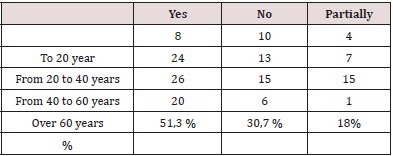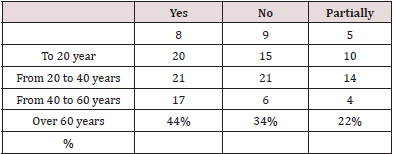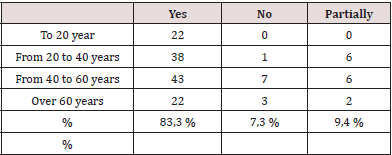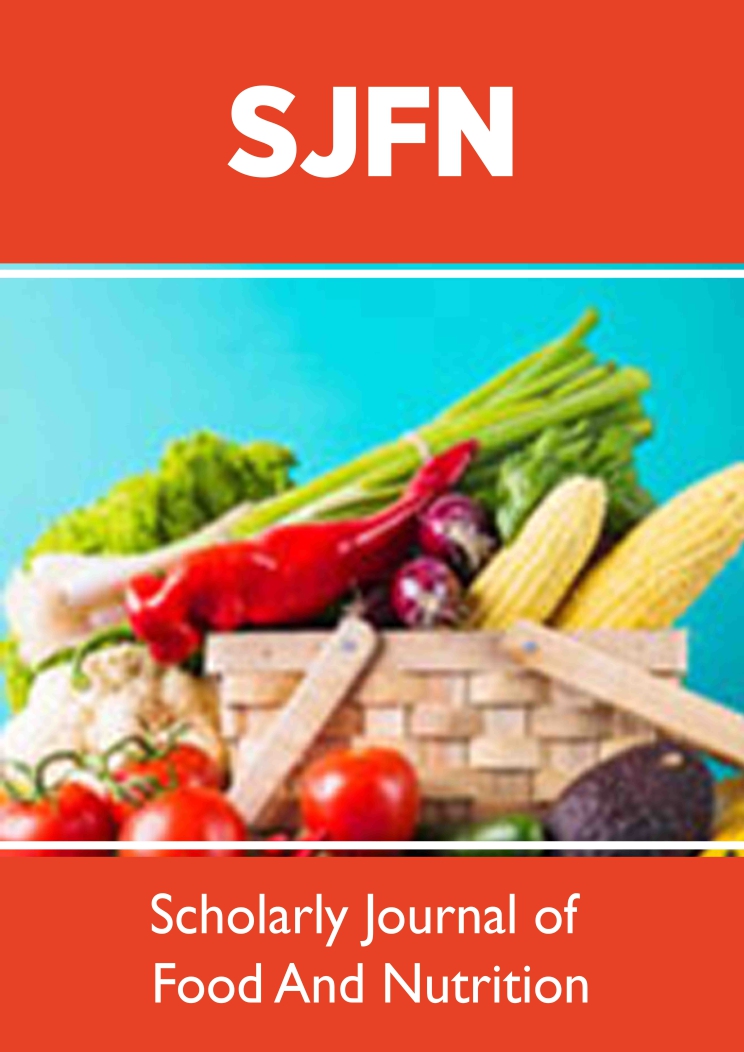
Lupine Publishers Group
Lupine Publishers
Menu
ISSN: 2638-6070
Research Article(ISSN: 2638-6070) 
Antimicrobial Activity of Extracts of Medicinal Plants Hipericum Perforatum, Matricaria Chamomilla, Geranium Sangguineum and Nepeta Cataria and their Application in the Treatment of Certain Infectious Diseases in Macedonia
Volume 2 - Issue 4Dragan Jovanov*
- Faculty of Management of environmental resources, MIT University in Skopje, Macedonia
Received: January 24, 2020; Published: February 05, 2020
*Corresponding author: Dragan Jovanov, Faculty of Management of environmental resources, MIT University in Skopje, Macedonia
DOI: 10.32474/SJFN.2020.02.000143
Abstract
Active ingredients from plants Hipericum perforatum, Matricaria chamomilla, Geranium sangguineum and Nepeta cataria manifested different antimicrobial activity in their use depending on the used concentration of the extract. Antibacterial activity and its examination were conducted survey of 150 people. Studies on antimicrobial activity of extracts of plants and their use in the treatment of certain infectious diseases studied, studied for 3 years. Antibacterial activity and its examination were conducted survey of 150 people. Studies on antimicrobial activity of extracts of plants and their use in the treatment of certain infectious diseases were studied in a period for 3 years. The goal of research in this paper is to determine the antimicrobial activity of extracts of medicinal plants: Hipericum perforatum, Matricaria chamomilla, Geranium sangguineum and Nepeta cataria and their use as adjuvant therapy in the treatment of certain infectious diseases. From all previously taken data it can be concluded that the least researched Nepeta cataria, and in that context we wanted to examine how the Macedonian population is familiar with the healing of this plant. Respondents pleaded that they are partially familiar with this medicinal plant and its antimicrobial activity.
Keywords: Essential Oils; Cilantro; Geranium; Chamomille; Cat Brush; Antimicrobial Activity Infectious Diseases
Introduction
For our research survey was conducted on the entire territory of the Republic of Macedonia, with interviewed people at different age. Respondents were 150 subjects for a period of 3 years. This working method was chosen to see how the Macedonian nation is familiar with these wild and medicinal plants, and how familiar extracts and essential oils are familiar with their antimicrobial activity [1].
Results Discussion
Aimed at raising self-awareness among respondents about the use of these medicinal plants at the end of the survey, it was very important to realize that people need additional training of experts, which actually wanted to initiate a reflection on this issue and phenomenon of interest [2]. The questionnaire which was used for our research consisted of six survey questions. Results of the survey are presented in the following twelve tables:
Did you know that St. John’s wort, Chamomile, Geranium and Nepeta Cataria have medicinal properties?
Table 1 The results of the first question most respondents i.e. 82.7% are familiar with the healing properties of St. John’s wort, Chamomille, Geranium and Nepeta Cataria, 9.3% of respondents are partially familiar with the healing properties of St. John’s wort, chamomille, geranium and cat brush. While 8% of respondents do not know that these plants have medicinal properties. In terms of gender most men and most women are familiar with the healing qualities of St. John’s wort, Chamomille, Geranium and Nepeta cataria, and some of them are only partially familiar (Table 2). In terms of the age most familiar with the healing qualities of St. John’s wort, Chamomille, Geranium and Nepeta cataria to respondents 40 to 60 years, also in this age group has the highest percentage of people who are not familiar with the healing properties of these plants. After them the most familiar faces of the age from 20 to 40 years. According to the results we perceive that most of the people above 60 years of age are familiar with the healing properties of St. John’s wort, Chamomille, Geranium and Nepeta cataria [3]. The same statistics also appears in people up to 20 years, with none of the respondents in this age category not stated that it is aware of the healing properties of St. John’s wort, Chamomille, Geranium and Nepeta cataria.
Do you use / have used St. John’s wort, chamomille, geranium or nepeta cataria in addition to the treatment of certain infectious diseases (colds, flu, sore throat)?
Table 3 From the results obtained above, we can see that in 72.7% of cases in the treatment of certain infectious diseases, St. John’s wort, Chamomille, Geranium and Nepeta cataria is used in addition to treatment. 23.3% of respondents said they partially use these medicinal plants in addition to the treatment of infectious diseases. A very small percentage, i.e. only 4% of respondents reported that St. John’s wort, Chamomille, Geranium and Nepeta cataria were not used. According to gender, women are used more St. John’s wort, Chamomile, Geranium and Nepeta cataria addition in the treatment of infectious disease, compared with men. Also, the data is matched with the partial use of these medicinal plants (Table 4). In terms of the age of respondents 40 to 60 years mostly used St. John’s wort, Chamomille, Geranium and Nepeta cataria addition in the treatment of infectious diseases. They are followed by persons aged 20 to 40 years, who also used these medicinal plants in infectious diseases. In this category of respondent’s partial use of these medicinal plants in addition to the treatment of certain infectious diseases, was the highest rate. According to the results none of the respondents over 60 years of age did not use St. John’s wort, Chamomile, Geranium and Nepeta cataria. The same statistics also appears in people up to 20 years, with most of them used these herbs, but there are people who partially or not at all used St. John’s wort, Chamomile, Geranium and Nepeta cataria.
Is the proper use of St. John’s wort, Chamomille, Geranium and Nepeta Cataria have Achieved the expected results?
Table 5 Out of the total number of respondents, we find that with proper use of St. John’s wort, Chamomille, Geranium and Nepeta cataria, 71.3 persons have achieved the expected results. While the 20.7% of respondents partly achieved the expected results. 8% of respondents did not achieved the expected results in the proper use of St. John’s wort, Chamomille, Geranium and Nepeta cataria in order to improve health conditions in infectious diseases. Regarding classification of respondent’s male and female, in this matter in both sexes in the proper use of St. John’s wort, Chamomille, Geranium and Nepeta cataria have achieved the expected results. In both cases, volunteers with proper use showed a partial effect or no effect. In the classification of respondents by age, we can conclude that among those 40 to 60 years reported that they had achieved positive results with these medicinal plants. Among subjects 20 to 40 years has the highest number of persons who reported that they had achieved partial results in the proper use of St. John’s wort, Chamomile, Geranium and Nepeta cataria, despite most of them who said they fully achieved the expected results (Table 6). Most people over 60 years have achieved the expected results, but some of them responded with partially not. Whereas, among those 20 years and over 60 years in common is that the same number of respondents reported that they have achieved the expected results in the proper use of these medicinal plants.
Do you know that the use of some of these plants is prohibited in certain situations (pregnancy, some autoimmune and malignant diseases)?
Table 7 Under certain conditions (pregnancy, some autoimmune and cancer) does not recommend the use of some of these plants. In this regard more than half, i.e. 51.3% of respondents said they were aware of negative effects that may occur with the use of these medicinal plants in the above conditions. 30, 7% were not familiar with the negative effects under certain conditions with the use of these medicinal plants. And partially familiar 18% of respondents. In both male and female respondents, the results expressed in percentages are similar, with the female partial awareness is higher (Table 8). People over 60 years in terms of information about the ban on the use of some of these plants in certain conditions (pregnancy, some autoimmune and cancer), reported that at they are least partially familiar. Among persons 40 to 60 years the proportion of people who are not familiar is equal to the percentage of people who are partially familiar with the prohibition on the use of these medicinal plants in certain conditions. Most of those 20 years of age are not informed about the ban on the use of St. John’s wort, Chamomille, Geranium and Nepeta cataria in the above medical conditions. While most of those years of age, those 20 to 40 years are aware of the warning [4].
Are you aware that some of these plants are contraindicated for use with certain drugs for the treatment of chronic diseases (pressure, heart disease, etc.)?
Table 9 In the context of the awareness of respondents that these medicinal plants are contraindicated for use in treating chronic diseases, most of the respondents, i.e. 44% said they are informed in this regard. Not informed 34% and partially informed 22% of respondents. Among females the level of information is greater, compared to males (Table 10). Among persons 40 to 60 years the number of people is equal who are informed and not informed of negative effects when using St. John’s wort, Chamomille, Geranium and Nepeta cataria with chronic diseases. People over 60 years of age have the lowest percentage of partial information on the matter. And people over 20 years have the lowest percentage of full awareness of negative effects.
Do you think you are sufficiently familiar with the rules on the use of herbal medicine and herbal remedies that need more education on their use?
Table 11 The majority of respondents i.e. 83.3% said they need more education about the use of herbal preparations. Of respondents 9.4% partially answered that they needed more education. A mere 7.3% of the respondents stated that they do not need additional training. The number of the females who reported that they needed partial education is the same as the number who said they did not need additional education in this direction (Table 12). In the context of the ninth question, all respondents to 20 years reported that they needed more education about the healing properties of herbal products and medicines. Among persons 40 to 60 years is the greatest need for additional education. Partial need for education is lowest among people over 60 years.
Conclusion
From the survey of this paper, we come to the conclusion that in Macedonia hardly anyone is not familiar with St. John’s wort, Chamomille, Geranium and Nepeta cataria and their health benefits. Also, we can conclude that the majority of respondents through the antimicrobial activity of these herbs have achieved the expected results. Most of the respondents are aware of the side effects under certain conditions, such as allergic reactions, pregnancy, some autoimmune malignant diseases, heart disease and others. We conclude that the respondents said that detailed information on the use, application, correct dosages, contraindications and side effects of these wild medicinal plants. In three years of research, we concluded that the respondents are not sufficiently informed about herbal medicines and herbal remedies and in this regard, they need more education. From the total number of respondents (male / female) in respect of all age limits have said that education would like to receive the professional, competent people who in their view are better suited to do the same. Most plants have medicinal properties, but all of them chamomile, St. John’s wort, Geranium and Nepeta cataria are most useful as a component of adjuvant therapy in the treatment of certain infectious diseases, which is why we chose them for research to prove their healing.
References
- Аdam K (1998) Antifungal activities of Origanum vulgare hirtum, Mentha spicata, Lavandula angustifolia and Salvia fruticosa oils against human pathogenic fungi. Journal of Agricultural and Food Chemistry 46(5): 1739-1745.
- Dorman HJD (2000) Antimicrobial agents from plants: antibacterial activity of plant volatile oil. Journal of Applied Microbiology 88(2): 308-316.
- Jovanov D (2013) Atlas of medicinal plants in the Republic of Macedonia.
- Jovanov D (2013) Natural medicinal aromatic and spice plants, their use and application to improve human health.

Top Editors
-

Mark E Smith
Bio chemistry
University of Texas Medical Branch, USA -

Lawrence A Presley
Department of Criminal Justice
Liberty University, USA -

Thomas W Miller
Department of Psychiatry
University of Kentucky, USA -

Gjumrakch Aliev
Department of Medicine
Gally International Biomedical Research & Consulting LLC, USA -

Christopher Bryant
Department of Urbanisation and Agricultural
Montreal university, USA -

Robert William Frare
Oral & Maxillofacial Pathology
New York University, USA -

Rudolph Modesto Navari
Gastroenterology and Hepatology
University of Alabama, UK -

Andrew Hague
Department of Medicine
Universities of Bradford, UK -

George Gregory Buttigieg
Maltese College of Obstetrics and Gynaecology, Europe -

Chen-Hsiung Yeh
Oncology
Circulogene Theranostics, England -
.png)
Emilio Bucio-Carrillo
Radiation Chemistry
National University of Mexico, USA -
.jpg)
Casey J Grenier
Analytical Chemistry
Wentworth Institute of Technology, USA -
Hany Atalah
Minimally Invasive Surgery
Mercer University school of Medicine, USA -

Abu-Hussein Muhamad
Pediatric Dentistry
University of Athens , Greece

The annual scholar awards from Lupine Publishers honor a selected number Read More...





